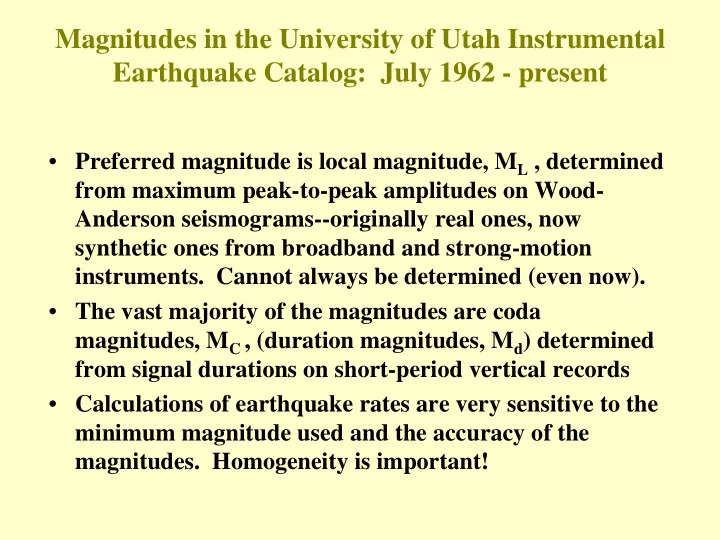

Magnitudes in the University of Utah Instrumental Earthquake Catalog: July 1962 - present • Preferred magnitude is local magnitude, M L , determined from maximum peak-to-peak amplitudes on Wood- Anderson seismograms--originally real ones, now synthetic ones from broadband and strong-motion instruments. Cannot always be determined (even now). • The vast majority of the magnitudes are coda magnitudes, M C , (duration magnitudes, M d ) determined from signal durations on short-period vertical records • Calculations of earthquake rates are very sensitive to the minimum magnitude used and the accuracy of the magnitudes. Homogeneity is important!
M L M C M W east-west component Synthetic Wood-Anderson seismograms for Crandall Canyon main shock north-south component
Short-Period Vertical-Component Record Station MLI, ML 3.8 Utah Earthquake, 6/28/1990
Data: 1995 - 2001 M C Calibrations Data: 1981 - 2001
Overview of AQMS Magnitude Determinations ( I) Automatic Near-Real-Time Magnitudes (1) Automatic M L s (and M E s) from rad2 and trimag. Feature continuous calculation of synthetic Wood Anderson (SWA) maximum 0-p amplitudes (etc.) using recursive time domain filter approximation (Kanamori et al., 1999) (2) Automatic M C s (M d s) from pick_ew and eqcoda. Widely used modules straight from earthworm (3) These programs are reasonably well documented
Overview of AQMS Magnitude Determinations ( III) Automatic Magnitudes with Options for Review and Revision (1) M L and M d are both calculated within Jiggle using different codes than for the automatic magnitudes. (2) Hypoinverse calls from Jiggle are only used for calculating locations. (3) Recalculation of M L or M d the first time initiates a complete automatic redetermination starting with the original waveforms. (4) Configuration of programs all done through Jiggle properties settings—88 of them! (5) Insufficient documentation —property definitions only.
Overview of AQMS Magnitude Determinations ( III) Negative Magnitudes are Supported
Rad2/Trimag: Produce automatic M L s • Pros --Very fast M L determinations --No sudden system load when a seismic event occurs • Cons --M L s reported in UU system are off by up to 0.3 unit --Search windows cannot be configured to exclude the P-wave window --Relatively high false alarm rate, at least in the northern California network
Pick_ew/Eqcoda: Produce automatic M C s • Pros --Robust size estimates --Sum of weights from eqcoda coda fits is a useful noise discriminant Cons • --Time delay of ~ 3 minutes for all but the smallest events
Jiggle M L Program • Pros --Highly configurable, with lots of options --Convenient method for repicking 0-p amplitudes --Easy switch between M L table and waveforms --Filtering options to enable M L s for small events • Cons --No option for using p-p amplitude instead of 0-p --”Richter” M L distance corrections don't match those used in rad2/trimag --Any way to prevent p-p amplitude picks on non-SWA records?
Jiggle M d Program • Pros --Highly configurable, with lots of options --Shows plots of coda decay fits superimposed on the waveforms --Easy switch between M d table and waveforms --Handles gain corrections via time-dependent end-of-coda thresholds stored in the database --Is it possible to update coda termination values automatically whenever simple responses are updated? • Cons --Poor documentation—no description of what it does
Recommend
More recommend